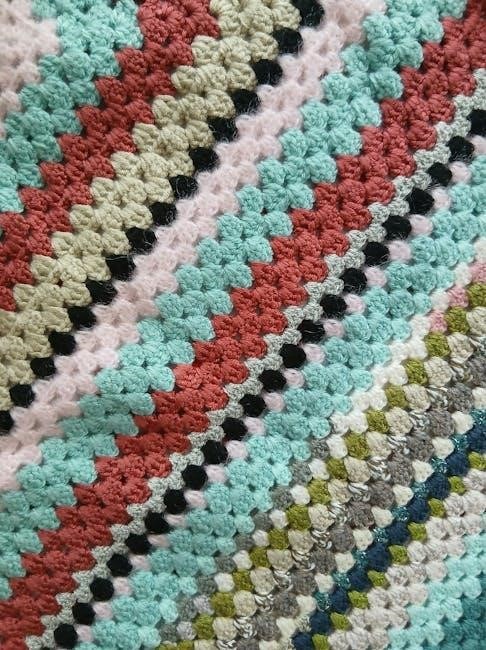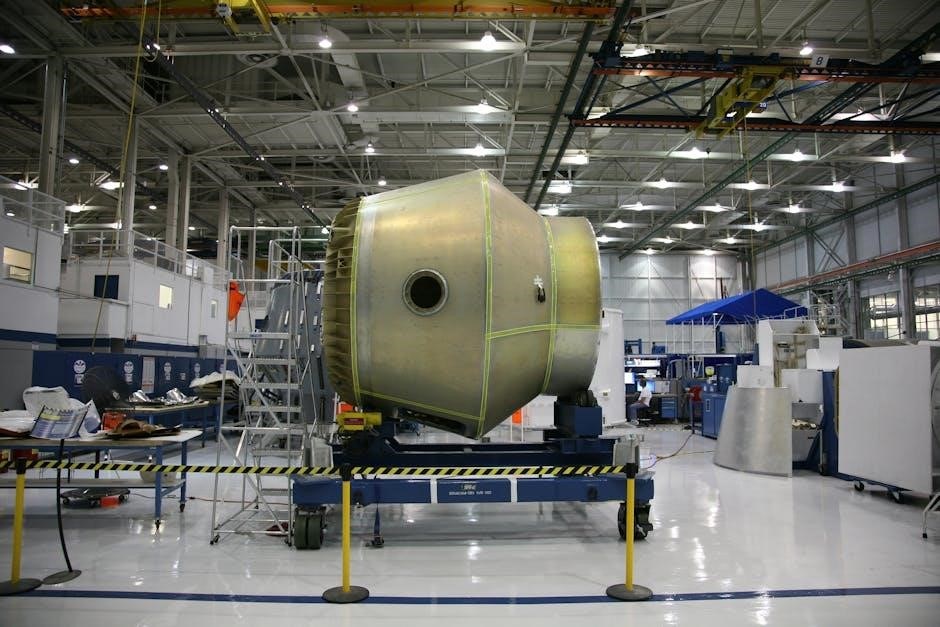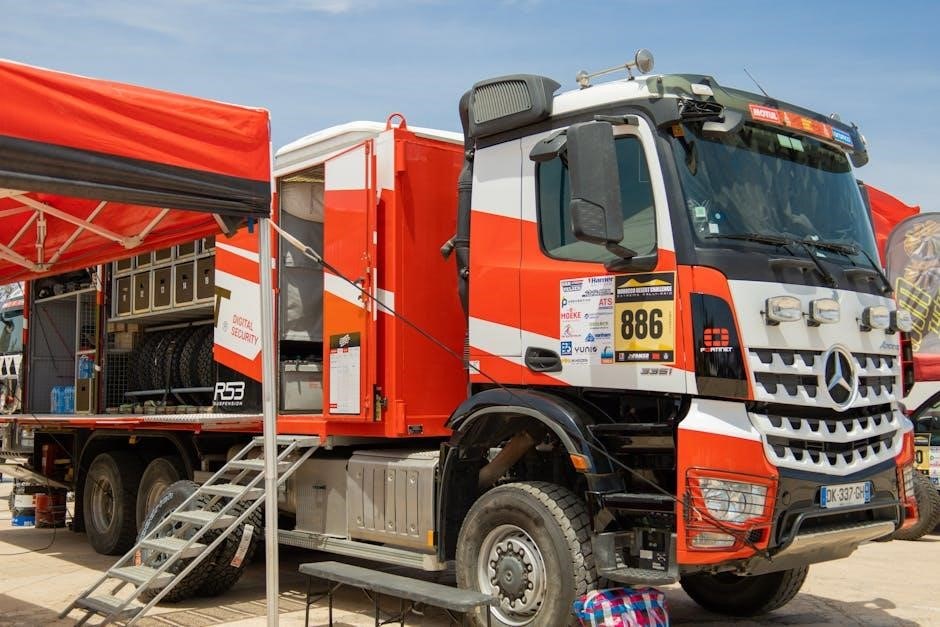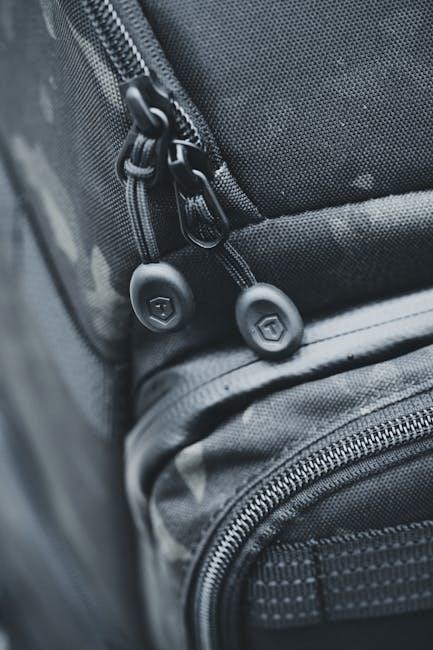The Singer Heavy Duty Stitch Guide is designed to help users master various stitch applications for thick fabrics and heavy-duty projects. It covers models like the 4423, 4432, and 4452, offering detailed instructions for straight, zigzag, and stretch stitches. This guide ensures optimal performance and versatility for sewists of all levels.
Model-Specific Guides
The Singer Heavy Duty Stitch Guide provides tailored instructions for models like the 4423, 4432, and 4452, ensuring users can optimize stitch settings for their specific machine and project needs effectively.
Understanding the Singer 4423 Stitch Applications
The Singer 4423 Heavy Duty sewing machine offers a variety of stitch applications tailored for durability and versatility. It features a range of stitches, including straight, zigzag, and stretch stitches, making it ideal for both heavy-duty and everyday sewing projects. For topstitching, the machine recommends using a straight stitch with a length of 3 to 3.5mm, sewing 1/4 to 3/8 inches from the fabric edge. The Singer 4423 also supports decorative stitching, allowing users to enhance their projects with precision. When working with medium-weight fabrics, a Topstitching Needle size 90/14 is suggested, while heavier fabrics may require a size 100/16 needle. The machine’s stitch guide provides clear instructions for selecting the right stitch type, adjusting stitch length, and setting the appropriate stitch width for optimal results. This model is particularly praised for its reliability in handling thick materials, making it a favorite among sewists who work with canvas, denim, or multiple fabric layers.
Exploring the Singer 4432 Stitch Guide
The Singer 4432 Heavy Duty sewing machine is renowned for its robust stitch options, designed to handle a wide range of fabrics. Its stitch guide outlines the use of straight, zigzag, and decorative stitches, with specific settings for heavy-duty projects. For topstitching, users are advised to set the machine to a straight stitch, maintaining a consistent stitch length of 3 to 3.5mm and sewing 1/4 to 3/8 inches from the fabric edge. The Singer 4432 also emphasizes the importance of using the correct needles, such as the Topstitching Needle in sizes 90/14 or 100/16, depending on fabric weight. Additionally, the machine supports one-step buttonholes, offering convenience for garment construction. The stitch guide provides detailed diagrams and instructions to help users navigate various stitch applications, ensuring professional-grade results. This model is particularly favored for its durability and ability to sew through multiple layers of thick fabrics, making it a go-to choice for upholstery and bag-making projects.
Mastering the Singer 4452 Stretch Stitch Guide
The Singer 4452 Heavy Duty sewing machine is equipped with advanced stretch stitch options, making it ideal for sewing elastic fabrics like spandex and knits. The stretch stitch guide provides detailed instructions for selecting the appropriate stitch patterns, such as the blue and red triple stitch (S1 and S2), which are designed for different stretch applications. These stitches are particularly useful for garments requiring flexibility, such as activewear or swimwear. The guide emphasizes the importance of maintaining proper tension and using the correct needle type to ensure smooth stitching. Users can customize stitch length and width to suit their fabric type, achieving professional-grade results. The Singer 4452’s stretch stitch capabilities, combined with its heavy-duty construction, make it a versatile choice for sewists working with challenging materials. This guide ensures users maximize the machine’s potential for stretch stitching projects.

Understanding Stitch Types
Stitch types are fundamental to sewing, with options like straight, zigzag, and stretch stitches catering to different fabrics and projects. Understanding each stitch’s purpose ensures proper fabric handling and desired results.
Working with the Straight Stitch
The straight stitch is the most basic yet essential stitch in sewing, ideal for seaming and topstitching. It’s suitable for most fabrics, including cotton, polyester, and linen. To achieve perfect straight stitches, ensure the fabric is aligned properly and use a matching thread color for a professional finish. For heavier fabrics, a longer stitch length (3-3.5mm) is recommended, while delicate materials may require a shorter length. Always use a sharp needle to prevent fabric tearing. The Singer Heavy Duty machines allow easy adjustment of stitch length, ensuring versatility for various projects. This stitch is also great for basting or gathering fabric, making it a go-to for both beginners and experienced sewists. Proper tension settings are crucial to avoid puckering or loose stitches, ensuring a clean and even seam every time.
Utilizing the Zigzag Stitch
The zigzag stitch is a versatile and essential stitch for sewing stretchy or delicate fabrics. It is ideal for preventing fraying on raw edges and for sewing knits or elastic materials. On Singer Heavy Duty machines, the zigzag stitch can be adjusted in width and length to suit different fabrics. For stretch fabrics, a narrower zigzag width is recommended, while wider widths work well for decorative purposes. When sewing with the zigzag stitch, use a stretch or ballpoint needle to ensure smooth stitching. Additionally, maintaining proper tension is crucial to avoid puckering or uneven stitching. This stitch is also useful for finishing seams without a serger, making it a must-have for garment construction and home decor projects. By adjusting the stitch settings, you can achieve professional-looking results on a variety of fabrics, from lightweight cotton to thick knits.
Perfecting the Stretch Stitch
The stretch stitch is a specialized stitch designed for sewing elastic or stretchy fabrics, ensuring they retain their flexibility after stitching. Singer Heavy Duty machines offer multiple stretch stitch options, including the triple stretch stitch, which is particularly effective for knits and spandex. To achieve optimal results, use a stretch needle, as it has a specially designed eye to handle elastic fibers without breaking. The machine’s stitch guide recommends setting the stitch length to medium and the width to narrow for most stretch fabrics. Tension settings should be adjusted slightly looser than those used for straight stitches to prevent puckering. When sewing, guide the fabric smoothly to maintain even stitch formation. This stitch is ideal for activewear, swimwear, and any project requiring maximum flexibility. By following these guidelines, you can achieve professional-looking stretch stitches with ease on your Singer Heavy Duty machine.

Customizing Your Stitches
Customizing your stitches on Singer Heavy Duty machines allows for personalized sewing experiences.
Adjust stitch length and width to suit various fabrics, ensuring precise control over your projects.
Adjusting Stitch Length for Different Fabrics
Adjusting stitch length is crucial for achieving professional results with your Singer Heavy Duty sewing machine. For lightweight fabrics like cotton or silk, a shorter stitch length (2-2.5mm) ensures a smooth finish. Medium-weight fabrics such as denim or canvas benefit from a mid-range stitch length (3-3.5mm), while heavier materials like canvas or Cordura require longer stitches (4-5mm) to prevent breaking. Always test your fabric to find the ideal setting for optimal durability and texture.
Setting the Right Stitch Width
Setting the right stitch width is essential for achieving professional results with your Singer Heavy Duty sewing machine. For delicate fabrics like silk or chiffon, a narrower stitch width (around 2-3mm) is recommended to prevent tearing. Heavier fabrics such as denim or canvas benefit from a wider stitch width (4-5mm) for added strength and durability. Stretchy fabrics may require a narrower width to maintain elasticity, while thick fabrics need a wider width to handle bulk. Always refer to your machine’s manual or online guides for specific settings, as Singer provides detailed recommendations for various materials. Additionally, consider the purpose of the seam—decorative stitches may require wider settings for visibility, while construction seams should match the fabric’s weight and use. Experimenting with scrap fabric can help you find the ideal stitch width for your projects. Adjusting stitch width in conjunction with stitch length and tension ensures seams lie flat and remain pucker-free. Using the appropriate presser foot for your stitch width further enhances stitch quality, preventing fabric dragging or bunching. By carefully adjusting the stitch width based on fabric type and project needs, you can optimize your sewing experience with the Singer Heavy Duty machine.
Managing Tension for Optimal Results
Proper tension adjustment is crucial for achieving smooth, even stitches with your Singer Heavy Duty sewing machine. Start by ensuring the bobbin is threaded correctly, as incorrect threading can lead to uneven tension. For most fabrics, the default tension setting (usually around 4) works well, but you may need to adjust it based on fabric thickness and type. If the top thread appears too tight or too loose, gently turn the tension dial until the stitches are balanced. For heavy-duty fabrics like denim or canvas, slightly increasing the tension can improve stitch consistency. Conversely, for delicate or stretchy fabrics, reducing tension prevents puckering or breaking. If you notice loops on the underside of the fabric, it may indicate that the bobbin tension is too loose. Always test your tension on scrap fabric before starting your project to ensure optimal results. Refer to your Singer Heavy Duty manual for specific guidance on tension adjustment for your machine model. Proper tension ensures professional-looking seams and prevents common sewing issues like uneven stitching or fabric distortion. Adjusting tension in conjunction with stitch length and width will help you achieve the best possible outcome for your sewing projects. Regularly checking and adjusting tension is a good habit to maintain the performance of your machine; By mastering tension control, you can handle a wide range of fabrics with confidence and precision.

Troubleshooting Common Issues
Troubleshooting common issues with the Singer Heavy Duty machine involves diagnosing needle problems, resolving tension imbalances, and ensuring proper threading. Regular checks can prevent many sewing mishaps and ensure smooth operation.
Diagnosing and Fixing Needle Problems
Needle issues are common in heavy-duty sewing machines. Symptoms like broken needles, skipped stitches, or uneven stitching often indicate a problem. First, check if the needle is installed correctly, ensuring it’s aligned properly and secured tightly. A needle not seated correctly can cause misalignment and poor stitch quality. If the needle breaks frequently, it may be due to incorrect threading, using the wrong needle type, or sewing too thick fabrics without the right presser foot. To fix, ensure the needle is compatible with your Singer Heavy Duty model and fabric type. Refer to the manual for specific needle recommendations. Also, verify that the tension settings are balanced, as improper tension can strain the needle. Regularly inspect and replace worn-out needles to maintain optimal performance and prevent further issues during sewing projects.
Resolving Tension Issues
Tension issues are a common challenge when using Singer Heavy Duty machines. If the stitches appear loose or tight, it may indicate uneven tension; Start by re-threading the machine, ensuring the thread follows the correct path and is seated properly in the tension discs. Use the adjustment dials to balance the upper and lower thread tensions. For thick fabrics, slightly tightening the upper tension can help achieve consistent stitches. Regularly cleaning the machine’s tension discs and lubricating moving parts can prevent friction-related problems. If issues persist, reset the tension to the default settings and test with a scrap fabric. Proper tension ensures smooth stitching and prevents fabric damage, making it essential for achieving professional results in heavy-duty sewing projects.
Essential Accessories
Essential accessories for Singer Heavy Duty machines include topstitching needles, walking feet, and specialized presser feet. These tools enhance stitching precision and versatility, ensuring optimal results for various fabrics and projects.
Using Topstitching Needles
Topstitching needles are crucial for achieving professional-looking stitches on heavy-duty fabrics. Designed with a larger eye, these needles accommodate thicker threads, reducing breakage and ensuring smooth stitching. For medium-weight fabrics, a size 90/14 needle is recommended, while heavier fabrics benefit from a 100/16 needle. Proper needle selection prevents thread tangling and maintains consistent tension; When sewing with topstitching thread, always use a matching needle to enhance visibility and durability. Regularly checking and replacing needles ensures optimal performance and prevents damage to your Singer Heavy Duty machine. By using the right needle, you can achieve crisp, even topstitching that elevates your sewing projects. This simple yet effective accessory is a must-have for any serious sewist working with heavy-duty materials.
Benefits of the Walking Foot
The walking foot is a highly versatile and essential accessory for Singer Heavy Duty sewing machines, particularly when working with thick fabrics, quilts, or multiple layers. Its unique design, with a moving part that mimics the motion of a human foot, ensures even fabric feeding, eliminating bunching or dragging. This makes it ideal for sewing through canvas, denim, and heavy-duty materials. The walking foot also excels at handling slippery fabrics, providing consistent control and preventing slippage. It is particularly useful for quilting and large-scale projects, where precise fabric alignment is crucial. By reducing the need for manual adjustments, the walking foot saves time and effort, allowing for smoother, more efficient sewing. Its durability and compatibility with Singer Heavy Duty machines make it a must-have accessory for sewists tackling challenging fabrics and complex projects.
Exploring Other Presser Feet
Beyond the walking foot, Singer Heavy Duty machines offer a variety of specialized presser feet designed to enhance sewing efficiency and creativity. The zigzag foot is ideal for general sewing, providing excellent visibility and control when working with straight or decorative stitches. The blind hem foot is perfect for creating nearly invisible hems on pants and skirts, while the overlock foot allows for professional-looking finished seams. Additional options like the buttonhole foot and the zipper foot simplify tasks such as adding buttons or inserting zippers. Each presser foot is crafted to handle specific sewing needs, ensuring precision and ease. By exploring these accessories, users can unlock the full potential of their Singer Heavy Duty machine, adapting it to a wide range of projects and fabric types with ease and professionalism.

Maintenance Tips
Regular maintenance is essential to ensure your Singer Heavy Duty sewing machine operates smoothly and lasts for years. Start by oiling the machine periodically, as specified in the manual, to keep moving parts lubricated. Clean the bobbin area and tension discs regularly to remove lint and debris, which can disrupt stitch quality. Check the needle frequently and replace it if it shows signs of wear, as a dull needle can cause skipped stitches or fabric damage. Properly thread the machine every time you sew to avoid tension issues. Finally, have your machine serviced professionally every 12-18 months to maintain its performance. By following these simple maintenance tips, you can ensure your Singer Heavy Duty machine continues to deliver precise stitches and handle heavy-duty projects effortlessly.

Common Heavy Duty Issues
Common issues with Singer Heavy Duty machines include needle breakage, improper threading, and tension imbalance. These problems can often be resolved with proper maintenance and adjustment techniques.
Fixing the Stitch Indicator
Fixing the stitch indicator on your Singer Heavy Duty machine involves a few careful steps. First, consult your manual to understand the mechanism. Turn off and unplug the machine for safety. Locate the stitch indicator, which may have been dislodged or misaligned. Gently realign it with the stitch selector dial, ensuring it clicks into place. If the indicator is damaged, replace it with a compatible part. Avoid forcing the alignment, as this could further damage the mechanism. Test the machine by selecting different stitches to ensure proper function. Regular maintenance and careful handling can prevent future issues with the stitch indicator.
Threading Properly
Proper threading is essential for optimal performance of your Singer Heavy Duty machine. Begin by turning the handwheel to raise the take-up lever. Follow the machine’s threading path, ensuring the thread passes through each guide correctly. Insert the thread through the tension discs, then pull it gently to set the tension. Finally, thread the needle from front to back. For the bobbin, place it in the bobbin case and guide the thread through the small hook, pulling it to secure. Always refer to your machine’s manual for specific threading instructions, as improper threading can lead to issues like uneven stitches or thread breakage. Regularly check and adjust the tension to maintain consistent stitching quality. Proper threading ensures smooth operation and professional results for all your sewing projects.

Heavy-Duty Sewing Features
The Singer Heavy Duty sewing machines are equipped with robust features designed to handle thick fabrics and demanding projects. These machines boast a heavy-duty metal frame and a powerful motor, ensuring stability and durability. They offer a wide range of stitch applications, including essential utility stitches, stretch stitches, and decorative options. With features like built-in needle threaders and one-step buttonholes, these machines streamline the sewing process. The heavy-duty models, such as the 4423, 4432, and 4452, are built to sew through multiple layers of canvas, denim, and cordura with ease. They also include a variety of presser feet, such as the walking foot, to manage tough fabrics. These machines are perfect for sewists who need reliable performance for heavy-duty projects, offering both power and precision to deliver professional results.

Tips for Sewing Thick Fabrics
Sewing thick fabrics requires the right techniques and tools to ensure successful results. Start by using a heavy-duty sewing machine, such as the Singer Heavy Duty models, which are designed to handle multiple layers of fabric. Choose the appropriate needle size and type, like a heavy-duty or denim needle, to prevent breakage and ensure clean stitching. Use a walking foot or Teflon foot to guide bulky fabrics smoothly. Increase the stitch length slightly for better penetration through thick materials. Always use high-quality, heavy-duty threads to match the fabric’s weight. Pre-pierce holes for buttons or zippers to avoid fabric tears. Tackle thick seams by trimming excess fabric and pressing them open. For added stability, interface or stabilizer can be applied to the fabric’s underside. By following these tips, you can achieve professional-looking results when sewing thick fabrics like canvas, cordura, or denim.

Thread Guidance and Threading
Proper threading is essential for smooth operation of your Singer Heavy Duty sewing machine. Begin by guiding the thread through the top thread guide, ensuring it clicks into place. Use the built-in needle threader to simplify the process of threading the needle. Gently pull the thread to set the tension, avoiding over-tightening, which can cause thread breakage. For heavy-duty fabrics, use high-quality, heavy-duty threads to match the fabric’s weight. Always cut the thread at an angle for easier needle threading. If threading issues persist, consult the manual or reset the machine’s tension settings. Regularly check and replace worn-out needles to prevent thread damage. Proper threading ensures consistent stitches and optimal performance when sewing thick or delicate fabrics. By following these steps, you can achieve professional results and extend the lifespan of your machine.
Bobbin Case Management
Proper management of the bobbin case is crucial for smooth sewing operations. Always ensure the bobbin is correctly inserted, clicking into place to maintain proper tension. Misalignment can lead to uneven stitching or thread tangling. Regularly inspect the bobbin case for lint or debris, which can affect stitch quality. Clean the case gently with a small brush to remove any buildup. When threading the bobbin, use the correct type of thread and ensure it is evenly wound. If the bobbin case tension seems off, adjust it using the small screwdriver provided in the manual. Maintain the standard tension range of 3-5 for most fabrics. For heavy-duty projects, slightly increase the tension if needed. Always use Singer-recommended bobbins to ensure compatibility and optimal performance. Proper bobbin case management ensures consistent stitching and prevents common sewing issues.

Using the Built-In Needle Threader
The Singer Heavy Duty sewing machines feature a convenient built-in needle threader to simplify the threading process. To use it, first, lift the presser foot to ensure the needle is in the correct position. Locate the needle threader, usually found near the needle bar, and gently pull it down. Thread the end of the thread through the threader’s small opening, ensuring it passes through smoothly. Release the threader, and the thread will be guided through the needle’s eye. Trim any excess thread close to the needle to prevent tangling. This feature saves time and reduces eye strain, especially for users with less dexterity. Always refer to the manual for specific instructions, as slight variations may exist between models like the 4423 and 4452. Proper use of the needle threader ensures smooth stitching and efficient sewing sessions.
The Singer Heavy Duty Stitch Guide is an indispensable resource for mastering your sewing machine’s capabilities. By understanding the various stitch types, adjusting settings for different fabrics, and maintaining your machine, you can achieve professional-quality results. Troubleshooting common issues and utilizing essential accessories like the walking foot and topstitching needles further enhance your sewing experience. Whether you’re working with thick fabrics or delicate materials, the Singer Heavy Duty range offers the versatility and power needed for any project. Remember to regularly refer to your machine’s manual and explore online tutorials for tips and tricks. With practice and proper care, your Singer Heavy Duty sewing machine will remain a reliable companion for years of creative sewing. Happy stitching!
